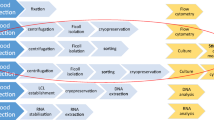Abstract
Cell therapy products represent a new trend of treatment in the field of immunotherapy and regenerative medicine. Their biological nature and multistep preparation procedure require the application of complex release criteria and quality control. Microbial contamination of cell therapy products is a potential source of morbidity in recipients. The automated blood culture systems are widely used for the detection of microorganisms in cell therapy products. However the standard 2-week cultivation period is too long for some cell-based treatments and alternative methods have to be devised. We tried to verify whether a shortened cultivation of the supernatant from the mesenchymal stem cell (MSC) culture obtained 2 days before the cell harvest could sufficiently detect microbial growth and allow the release of MSC for clinical application. We compared the standard Ph. Eur. cultivation method and the automated blood culture system BACTEC (Becton Dickinson). The time to detection (TTD) and the detection limit were analyzed for three bacterial and two fungal strains. The Staphylococcus aureus and Pseudomonas aeruginosa were recognized within 24 h with both methods (detection limit ~10 CFU). The time required for the detection of Bacillus subtilis was shorter with the automated method (TTD 10.3 vs. 60 h for 10–100 CFU). The BACTEC system reached significantly shorter times to the detection of Candida albicans and Aspergillus brasiliensis growth compared to the classical method (15.5 vs. 48 and 31.5 vs. 48 h, respectively; 10–100 CFU). The positivity was demonstrated within 48 h in all bottles, regardless of the size of the inoculum. This study validated the automated cultivation system as a method able to detect all tested microorganisms within a 48-h period with a detection limit of ~10 CFU. Only in case of B. subtilis, the lowest inoculum (~10 CFU) was not recognized. The 2-day cultivation technique is then capable of confirming the microbiological safety of MSC and allows their timely release for clinical application.

Similar content being viewed by others
Abbreviations
- ASBR:
-
Aspergillus brasiliensis
- ATMP:
-
Advanced therapy medicinal product
- BSSP:
-
Bacillus subtilis
- CAAL:
-
Candida albicans
- CFU:
-
Colony forming unit
- GMP:
-
Good manufacturing practice
- MSC:
-
Mesenchymal stem cell
- PSAE:
-
Pseudomonas aeruginosa
- SDA:
-
Sabouraud dextrose agar
- STAU:
-
Staphylococcus aureus
- T:
-
Thioglycollate medium
- TSA:
-
Trypton soya agar
- TTD:
-
Time to detection
References
Brecher ME, Hay SN (2005) Bacterial contamination of blood components. Clin Microbiol Rev 18:195–204
Flory E, Reinhardt J (2013) European regulatory tools for advanced therapy medicinal products. Transfus Med Hemother 40:409–412
Hocquet D, Sauget M, Roussel S, Malugani C, Pouthier F, Morel P et al (2014) Validation of an automated blood culture system for sterility testing of cell therapy products. Cytotherapy 16:692–698
Kamble R, Pant S, Selby GB, Kharfan-Dabaja MA, Sethi S, Kratochvil K et al (2005) Microbial contamination of hematopoietic progenitor cell grafts—incidence, clinical outcome, and cost-effectiveness: an analysis of 735 grafts. Transfusion 45:874–878
Khuu HM, Stock F, McGann M, Carter CS, Atkins JW, Murray PR et al (2004) Comparison of automated culture systems with a CFR/USP-compliant method for sterility testing of cell-therapy products. Cytotherapy 6:183–195
Khuu HM, Patel N, Carter CS, Murray PR, Read EJ (2006) Sterility testing of cell therapy products: parallel comparison of automated methods with a CFR-compliant method. Transfusion 46:2071–2082
Klein MA, Kadidlo D, McCullough J, McKenna DH, Burns LJ (2006) Microbial contamination of hematopoietic stem cell products: incidence and clinical sequelae. Biol Blood Marrow Transplant 12:1142–1149
Larrea L, de la Rubia J, Soler MA, Ribas P, Fernandez JM, Picon I et al (2004) Quality control of bacterial contamination in autologous peripheral blood stem cells for transplantation. Haematologica 89:1232–1237
Lazarus HM, Magalhaes-Silverman M, Fox RM, Creger RJ, Jacobs M (1991) Contamination during in vitro processing of bone marrow for transplantation: clinical significance. Bone Marrow Transplant 7:241–246
Lowder JN, Whelton P (2003) Microbial contamination of cellular products for hematolymphoid transplantation therapy: assessment of the problem and strategies to minimize the clinical impact. Cytotherapy 5:377–390
Majado MJ, García-Hernández A, Morales A, González C, Martínez-Sánchez V, Menasalvas A et al (2007) Influence of harvest bacterial contamination on autologous peripheral blood progenitor cells post-transplant. Bone Marrow Transplant 39:121–125
Maslova O, Novak M, Kruzliak P (2015) Umbilical cord tissue-derived cells as therapeutic agents. Stem Cells Int. http://www.hindawi.com/journals/sci/aa/150609/
Parveen S, Kaur S, David SA, Kenney JL, McCormick WM, Gupta RK (2011) Evaluation of growth based rapid microbiological methods for sterility testing of vaccines and other biological products. Vaccine 29:8012–8023
Roziakova L, Mistrik M, Batorova A, Kruzliak P, Bojtarova E, Dubrava J, Gergel J, Mladosievicova B (2015) Can we predict clinical cardiotoxicity with cardiac biomarkers in patients after haematopoietic stem cell transplantation? Cardiovasc Toxicol 15:210–216
Soncin S, Cicero VL, Astori G, Soldati G, Gola M, Sürder D et al (2009) A practical approach for the validation of sterility, endotoxin and potency testing of bone marrow mononuclear cells used in cardiac regeneration in compliance with good manufacturing practice. J Transl Med 7:78
Störmer M, Wood EM, Schurig U, Karo O, Spreitzer I, McDonald CP et al (2014) Bacterial safety of cell-based therapeutic preparations, focusing on haematopoietic progenitor cells. Vox Sang 106:285–296
Acknowledgments
Supported by the project Ministry of Health, the Czech Republic, for conceptual development of research organization 00669806 (Faculty Hospital in Plzen, Czech Republic) and by the Grant of Bone Marrow Transplant Foundation.
Author information
Authors and Affiliations
Corresponding authors
Ethics declarations
Disclosure of interest
The authors have no commercial, proprietary, or financial interest in the products or companies described in this article.
Rights and permissions
About this article
Cite this article
Lysák, D., Holubová, M., Bergerová, T. et al. Validation of shortened 2-day sterility testing of mesenchymal stem cell-based therapeutic preparation on an automated culture system. Cell Tissue Bank 17, 1–9 (2016). https://doi.org/10.1007/s10561-015-9522-9
Received:
Accepted:
Published:
Issue Date:
DOI: https://doi.org/10.1007/s10561-015-9522-9




